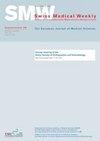A cohort study of patients hospitalised with SARS-CoV-2 infection in Ontario: patient characteristics and outcomes by wave
IF 2.1
4区 医学
Q2 MEDICINE, GENERAL & INTERNAL
引用次数: 0
Abstract
INTRODUCTION: Each wave of the COVID-19 pandemic exhibited a unique combination of epidemiological, social and structural characteristics. We explore similarities and differences in wave-over-wave characteristics of patients hospitalised with COVID-19. METHODS: This was a population-based study in Ontario province, Canada. Patients hospitalised with SARS-CoV-2 between 26 February 2020 and 31 March 2022 were included. An admission was considered related to SARS-CoV-2 infection if the provincial inpatient or outpatient hospital databases contained the ICD-10 diagnostic codes U071/U072 or the Ontario Laboratories Information System indicated a positive SARS-CoV-2 test result (PCR or rapid antigen testing) during the admission or up to two weeks prior. The primary outcome was 90-day mortality (modified Poisson regression). Secondary outcomes were use of critical care during the admission (logistic regression) and total length-of-stay (linear regression with heteroskedastic-consistent standard-error estimators). All models were adjusted for demographic characteristics, neighbourhood socioeconomic factors and indicators of illness severity. RESULTS: There were 73,201 SARS-CoV-2-related admissions: 6127 (8%) during wave 1 (wild-type), 14,371 (20%) during wave 2 (wild-type), 16,653 (23%) during wave 3 (Alpha), 5678 (8%) during wave 4 (Delta) and 30,372 (42%) during wave 5 (Omicron). SARS-CoV-2 was the most responsible diagnosis for 70% of admissions during waves 1–2 and 42% in wave 5. The proportion of admitted patients who were long-term care residents was 18% (n = 1111) during wave 1, decreasing to 10% (n = 1468) in wave 2 and <5% in subsequent waves. During waves 1–3, 46% of all admitted patients resided in a neighbourhood assigned to the highest ethnic diversity quintile, which declined to 27% during waves 4–5. Compared to wave 1, 90-day mortality was similar during wave 2 (adjusted risk ratio [aRR]: 1.00 [95% CI: 0.95–1.04]), but lower during wave 3 (aRR: 0.89 [0.85–0.94]), wave 4 (aRR: 0.85 [0.79–0.91]) and wave 5 (aRR: 0.83 [0.80–0.88]). Improvements in survival over waves were observed among elderly patients (p-interaction <0.0001). Critical care admission was significantly less likely during wave 5 than previous waves (adjusted odds ratio: 0.50 [0.47–0.54]). The length of stay was a median of 8.5 (3.6–23.8) days during wave 1 and 5.3 (2.2–12.6) during wave 5. After adjustment, the mean length of stay was on average –10.4 (–11.1 to –9.8) days, i.e. shorter, in wave 5 vs wave 1. CONCLUSION: Throughout the pandemic, sociodemographic characteristics of patients hospitalised with SARS-CoV-2 changed over time, particularly in terms of ethnic diversity, but still disproportionately affected patients from more marginalised regions. Improved survival and reduced use of critical care during the Omicron wave are reassuring.安大略省因感染 SARS-CoV-2 而住院的患者队列研究:按波次分列的患者特征和治疗效果
简介:COVID-19 大流行的每一波都表现出独特的流行病学、社会和结构特征。方法:这是一项在加拿大安大略省进行的基于人口的研究。研究纳入了 2020 年 2 月 26 日至 2022 年 3 月 31 日期间因感染 SARS-CoV-2 而住院的患者。如果省住院或门诊数据库中包含 ICD-10 诊断代码 U071/U072 或安大略省实验室信息系统显示入院期间或入院前两周内 SARS-CoV-2 检测结果(PCR 或快速抗原检测)呈阳性,则认为该患者的入院与 SARS-CoV-2 感染有关。主要结果是 90 天死亡率(修正泊松回归)。次要结果是入院期间使用重症监护(逻辑回归)和总住院时间(使用异方差一致的标准误差估计器的线性回归)。所有模型都根据人口统计学特征、社区社会经济因素和疾病严重程度指标进行了调整:第 1 波(野生型)有 6127 人(8%),第 2 波(野生型)有 14371 人(20%),第 3 波(阿尔法型)有 16653 人(23%),第 4 波(德尔塔型)有 5678 人(8%),第 5 波(奥米克隆型)有 30372 人(42%)。在第 1-2 波和第 5 波分别有 70% 和 42% 的入院患者被诊断为 SARS-CoV-2。入院患者中,长期护理居民的比例在第 1 次波次中为 18%(n = 1111),在第 2 次波次中降至 10%(n = 1468),在随后的波次中小于 5%。在第 1-3 波期间,46% 的入院患者居住在种族多样性最高的五分位数社区,而在第 4-5 波期间,这一比例下降到 27%。与第 1 波相比,第 2 波的 90 天死亡率相似(调整风险比 [aRR]:1.00 [95% CI:0.95-1.04]),但第 3 波(aRR:0.89 [0.85-0.94])、第 4 波(aRR:0.85 [0.79-0.91])和第 5 波(aRR:0.83 [0.80-0.88])较低。老年患者的存活率在各阶段均有所提高(p-交互作用<0.0001)。与前几波相比,第 5 波患者入院接受重症监护的几率明显降低(调整后的几率比:0.50 [0.47-0.54])。第 1 波的住院时间中位数为 8.5 天(3.6-23.8 天),第 5 波为 5.3 天(2.2-12.6 天)。结论:在整个大流行期间,SARS-CoV-2 住院病人的社会人口学特征随着时间的推移发生了变化,特别是在种族多样性方面,但来自较边缘化地区的病人仍然受到不成比例的影响。令人欣慰的是,在 "Omicron浪潮 "期间,患者的存活率有所提高,重症监护的使用也有所减少。
本文章由计算机程序翻译,如有差异,请以英文原文为准。
求助全文
约1分钟内获得全文
求助全文
来源期刊

Swiss medical weekly
医学-医学:内科
CiteScore
5.00
自引率
0.00%
发文量
0
审稿时长
3-8 weeks
期刊介绍:
The Swiss Medical Weekly accepts for consideration original and review articles from all fields of medicine. The quality of SMW publications is guaranteed by a consistent policy of rigorous single-blind peer review. All editorial decisions are made by research-active academics.
 求助内容:
求助内容: 应助结果提醒方式:
应助结果提醒方式:


